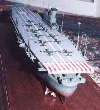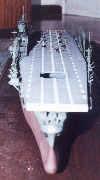| A Bit of a History
Named after the Japanese province Shinano, the IJN Shinano was initially
built to be the 3rd Yamato-class battle ship of the Nihon Kaigun (Imperial
Japanese Navy). When the Japanese realized the importance of aircraft
cover in its previous naval battles, they switched her construction from
battleship to aircraft carrier - that is why it used the Yamato-like hull.
It was to be the largest Aircraft Carrier in World War II with a total
capacity of 71,890 tons. It was to serve both as an Aircraft Carrier and
a supply vessel for the Imperial Japanese forces in the Pacific Theater. |
Click the images
below to enlarge

|
| In November 28, 1944, the Shinano was declared ready for
sea trials. It set sail bringing with her 2,515 officers, crew, 40
civilian employees and 300 construction workers to witness the event.
Unfortunately for the Shinano, she was spotted by an American submarine
- the USS Archerfish (SS-311) commanded by Joseph F. Enright. Contradicting
US Naval Intelligence, only Captain Enright believed that a carrier as
large as the Shinano was being built and on that day he proved himself
right. He launched 6 torpedoes to the Shinano where 4 of them hit her to
stop her dead in mid-sea. In panic, the people on board the Shinano abandoned
ship. The three escort destroyers started saving them instead of
hunting the USS Archerfish. After only 17 hours at sea, the Shinano
sunk and took with her 1,435 officers, sailors and civilians to her grave
without a single shot fired or a single plane launched. |
|
|
| When I bought the Shinano for almost $200, I thought that
it would be a good kit. I convinced Jun Villalon, a close friend
of mine, to help me build this kit since I didn't have much time to finish
it before our scheduled IPMS exhibit in June, 2001. |
The kit had many flaws. The plastic used for the antennae were too
brittle that the kit had some parts broken upon opening of the box. The
deck was about 1/8Ē longer than the hull and the support trusses.
Due to this, we had to do extensive refitting to make the deck fit without
sacrificing accuracy and aesthetics. The guns did not fit with the
turrets well and the planes were too few for a kit this large (It had only
12 planes and one of them had to be placed on the elevators!). The
kit instructions were purely pictorial. No words were used to explain
the assembly - which made assembly even more complicated. The parts
and the sprues were not numbered so you will have to depend on the diagram
printed on the instruction guide (which wasnít very clearly printed).
The one thing that impressed me was the scale of the ship. |
 |
|
|
| Jun and I spent 2 months building the Shinano. That is about
3 to 4 hours each day, 5 days a week on the average. We sanded off
the plastic railings off the entire walkway as well as the balconies under
the deck and replaced them with GMM's 1/200 scale generic brass photoetch
railings. We decided that it was the closest scale to available in
the after-market and it made the kit look impressive. We placed photo-etched
railings on the superstructure. We sliced off the elevator - which
looked like a miniaturized swimming pool. The kit intended the elevator
to be used as the switch for the props (the kit is motorized). The
kit had a gearbox, stainless-steel props, wires and a switch to go with
it. We scratch-built a portion of the hangar so it can be seen when the
elevator is down. We hope to mold more planes later so we can fill
the hangar with more planes. |
 |
| Since I work for our own printing press, we used old lead plates
(the kind you use in offset printing) instead of styrene sheets to scratch
build the hangar. It was easier to use these plates since it was
easier to cut, bend/twist and shape. It was also smooth so painting it
was never a problem. We detailed the planes by adding gun barrels and antennae
in the wings and the rear of the canopies and a thin stretched sprue for
the wire connecting it to the tail. |
 |
|
|
| We painted the Zeros with IJN Green and IJN Grey using Hasegawa and
internet provided information. The Judy's were painted similarly.
The wings had yellow markings at the front and painted the rudders with
the appropriate wing markings. |
 |
|
|
| We painted the deck with 4 parts Tamiya Light Gray and
1 part Tamiya Flat Black acrylic. We painted the body of the ship
with Aeromasterís IJN Green and Model Masterís IJN Dark Green. We
had to look at Tamiya's 1/700 scale painting instructions and box art to
arrive with the correct camouflage pattern. The kit doesn't have
painting instructions. |
| We then used Tamiya Hull Red for the hull and Gold for the props. We
used light gray pastels to highlight the railings. When the painting
was completed, we over-sprayed it with Humbrolís Matte Cote. Remember
that the ship is relatively new when it went to sea and was sunk so weathering
was not really required here. After that we washed the corners, guns/turrets
and hull details with diluted black oil paint to highlight the few details
it had. When it was dry (over 24-hours!), we over-sprayed it again
with Matte Coat since the oils have a tendency to become semi-glossed when
dry. |
 |
|
|
| We provided a base for the Shinano and had a separate plate done.
The plate provided by the kit is misspelled "Sinano" - so that had to end
up in the trash.
We think that the Shinano we built was ready for the exhibit.
But to our standards, we still feel we have to add more planes. We
are also looking at molding some resin figures later. If we do that,
we will add the pics to this page. |
 |
|
|
Ship : Imperial Japanese Navy Carrier SHINANO
Scale : 1/250
Kit : Doyusha
Builders : Noel Carpio and Jun Villalon, IPMS Philippines |
|
|
|

© ModelWarships.com
|





